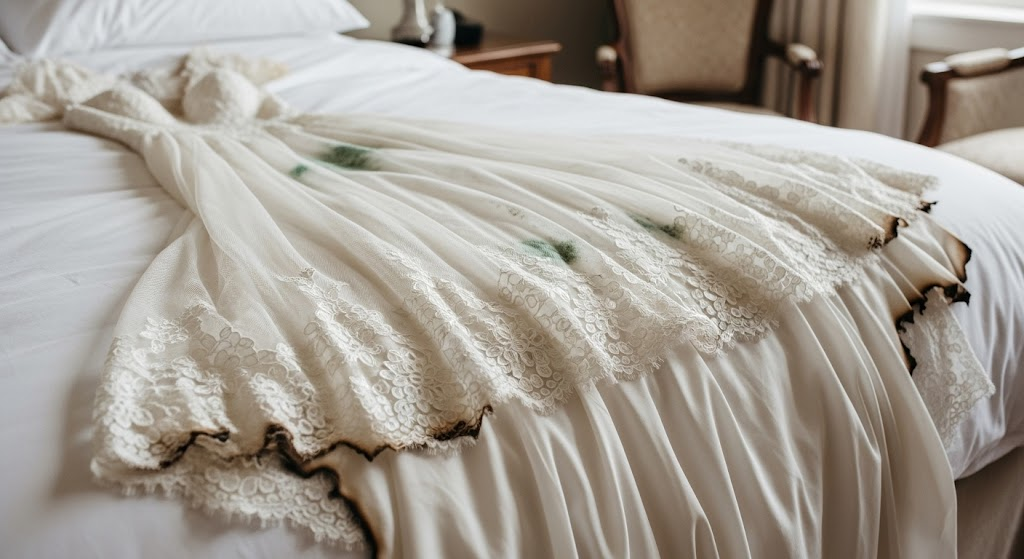Most brides don't realize the damage until it's too late...
You think your wedding dress is safe. It's stored in a closet and sealed in a box. Maybe you haven't looked at it in years - well, that's the REAL problem.
Here's what no one tells you -
-
Your wedding dress could be slowly destroying itself right now - even if you haven't touched it.
-
Mold can start growing in as little as 24 to 48 hours if your dress was stored with even a little moisture.
-
Burn marks and smoke particles can embed deep in the fabrics.
-
And that airtight plastic box you thought was safe, it could be causing chemical yellowing and fabric breakdown.
Brides often find out the truth the day they go to look at the dress again - to take photos, to show it to their daughter, to renew vows - and by then, the damage ruins the dress.
Sometimes, the damage isn't hidden; it's clear and easy to see. Have you heard about the fire at a New York bridal boutique? It has destroyed more than 200 wedding gowns in minutes.
The heartbreak is real. So, this blog is your WARNING and HOPE.
If you really care about the dress, your memories, and everything that the gown represents, you can't afford to wait for long.
What Should You Do Immediately If Your Dress Gets Burnt or Mold-Damaged?

When disaster happens, your instinct is to panic or try to fix it yourself-
-
whether it's a mark from a last-minute ironing or
-
mold damage from unexpected water damage
However, in reality, the first step is to know whether your wedding dress can be saved or permanently ruined. Here is what you should do immediately -
1. Stop Everything
WARNING: Do Not Fix It Yourself!! Your first reaction can be to -
-
Google a home remedy,
-
Get a stain remover, or
-
Iron to "smooth things out."
Well, DON'T DO IT. Wedding dresses are made from delicate, heat-sensitive fabrics like satin, tulle, silk, and lace. These can be irreversibly damaged if not cleaned properly.
A Reddit user shared their experience after accidentally burning their expensive satin wedding dress with an iron. When trying to smooth out a wrinkle, they left a brown scorch mark that could not be reversed.
DIY fixes can lock in damage. Do nothing until you've assessed the situation fully.
2. Remove It from the Harmful Environment

Don’t ever leave your dress locked in a heat, humidity, moisture, or soot. It can make your dress even worse.
So, remove your dress from that harmful condition quickly to avoid any mishaps.
-
If it’s mold-damaged:
You can move it to a cool, dry place with air circulation. Don’t consider storing it in a plastic bag. It can trap moisture.
-
If it’s burnt or exposed to smoke:
Avoid touching or folding it. Lay it flat or hang it in a breathable garment bag. It can prevent setting wrinkles or spreading soot.
One bride on Reddit stored her dress in a basement. It was flooded during a storm. The mold that developed could have been prevented—or at least minimized. For that, the dress should have been removed sooner from the damp space.
3. Do Some Small Inspections
When you keep your dress in a safe location, make sure to inspect it for signs of damage. Also, use clean hands or gloves if needed.
You Need To Look for:
-
Any Discoloration (yellowing, brown marks, or gray spots)
-
Yellowing fabric
-
White or green fuzzy patches (a sign of mold)
-
Tears or fraying along seams or burnt areas
Also Smell:
-
Sour, musty, or damp odors (typical of mold)
-
Smoke or burnt fabric smell
Look for the scope of the damage before you do anything else. It helps professionals know what can be saved.
4. Contact a Professional Wedding Dress Restoration Specialist

Not every dry cleaner has the tools or expertise to deal with wedding dresses, especially ones with damage. You need to find a professional who specializes in wedding gown restoration.
They have access to the right methods and experience to deal with both mold and burn damage.
Don’t assume that your local dry cleaner is equipped to handle this. As shared in a heartbreaking Reddit thread, one bride trusted her gown to a regular cleaner who ended up shrinking and yellowing the fabric, rendering it unwearable.
You need to look for certified or highly reviewed wedding gown cleaners and restorers like DressPreservation.com experts. Ask for references or examples of past restoration work.
Is It Possible To Save Your Burnt or Mold-Damaged Wedding Dress?

1. If Your Dress Was Burnt Or Smoke-Damaged
Possibility For Restoration
These are superficial or surface-level issues that professionals for wedding dress preservation can handle -
Smoke Odors
Smoke smell can often be removed using ozone treatments or specialized dress cleaning techniques. It works because the fabric is not physically damaged; it is just infused with odor molecules.
Minor Scorch Marks
If there is slight discoloration or head marks, these can sometimes be faded.
For example, Someone on Reddit scorched their satin dress when ironing. Even minor scorching can be less visible if those is caught early.
Singed Layers
If only outer or decorative layers are lightly damaged, those can be replaced. It is restorable because the base structure of the dress is intact.
When Can It Not Be Fully Restored?

These refer to the severe thermal damage where the fabric is structurally compromised.
Charred Fabric
If some parts are burned through or blackened to ash, that part is physically destroyed. The result: Those areas can't be restored but can only be removed or replaced.
Melted Structure or Beading
Synthetic fabrics and embellishments can melt or fuse under high heat. And why it's a problem - Once it's melted, the shape and texture are permanently altered.
In cases like this, a seamstress can reconstruct the dress while keeping the undamaged parts protected.
2. If your Dress Has Mold Or Water Damage

These are early-stage or cosmetic issues that can be professionally treated with wedding dress cleaning -
Can Be Restored
Early Mold Growth
If mold has just started growing and hasn't penetrated deep into the fabrics, you can remove it with proper chemical treatment.
Musty Odors or Water Staining
These are early-stage or cosmetic issues that can be treated easily -
Rust From Metal Embellishments
Rust stains from the hooks, boning, or zippers can be treated with just removers.
Can't Be Fully Restored
These are some cases where fiber can be restored fully -

Deep Black Mold
If the mold has deeply impacted the fabric, it can stain permanently and even weaken the fibers. It possesses health risks and limits restoration.
Fabric Rot Or Thread Weakening
Water can get into the natural fibers with time. You may see tearing with even less to no pressure.
In these cases, even if the dress looks good, it may fall apart when cleaning or restoring. A seamstress can reuse the non-damaged portions to create a new garment.
3. The “Maybe” Category – Ask a Specialist

These issues are categorized under the grey zone. So, what does that mean? They are not obviously restorable, but not completely ruined either.
It means restoration can be possible. However, it depends on the type of dress.
1. Heavy Yellowing
Yellowing happens when fabrics, especially natural fibers like silk, cotton, or rayon, oxidize over time. It may come from:
-
Improper storage (plastic bags, humidity)
-
Residual body oils or stains
-
UV exposure
It is possible to get rid of yellowing with gentle whitening agents or oxidizing cleaners.
However, heavy or uneven yellowing can leave permanent marks, especially in aged silk or blends.
2. Beaded or Embroidered Gowns with Hidden Mold
Mold can grow beneath or inside dense embellishments where moisture gets trapped.
E.g., inside beaded appliqués, under embroidery, between layers.
Cleaning mold here risks damaging the embellishment. It could cause further degradation.
Some glues or threads holding beading may become weak when cleaned.
The Sooner You Act, the Better Your Chances
Time matters more than you think. Smoke, mold, and water damage don’t just pause when an initial incident happens. The longer you wait, the more difficult (or impossible) restoration becomes.
Quick action isn’t just theoretical. It actually has saved real dresses in high-pressure situations.
In 2024, a Michigan bridal boutique suffered a fire just days before multiple weddings. Most of the gowns were damaged, and the shop owner worked urgently with professional restoration teams to fix them in time.
It's all due to the immediate intervention; some brides were still able to wear their original dresses.
Here is how quick action saves dresses -
To Sum Up
In most cases, wedding dress damage can be reversed if these things are addressed earlier -
-
smoke,
-
mold,
-
water, or
-
age.
Whether your gown is yellowed, musty, or slightly scorched, you can easily restore it with the right help.
If you’re unsure, now is the time to reach out to a specialist for an honest assessment. And, the DressPreservation.com experts can help you throughout the process.
You don’t have to lose the most meaningful dress you’ve ever worn. There’s a good chance it can be saved, cherished, or even worn again with the right care.
Frequently Asked Questions
Is it possible to still preserve my wedding dress after 10 years?
Yes, but it depends on its condition. Older dresses may show yellowing, stains, or structural weakening. However, many can still be cleaned and preserved if the damage isn’t too severe. A specialist can assess and advise on your best options.
What if your dress smells like mildew but looks clean?
A musty or mildew smell indicates hidden mold or moisture exposure, even if there are no visible stains. It should be addressed promptly to prevent deeper fabric damage or health risks during storage.
Can I wear my dress again after it’s been preserved?
Yes—preservation is reversible in most cases. If your dress was stored properly in breathable, acid-neutral tissue paper, it can usually be removed, refreshed, and worn again. It is done for vow renewals, photos, or future generations.
What to do with a dress - clean or preserve first?
Always clean first. Preservation without cleaning traps stains, oils, and potential mold, which can cause long-term damage. Cleaning removes contaminants and prepares the dress for safe, long-term storage.








